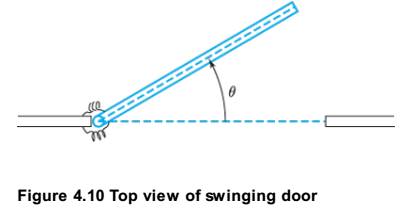
Swinging Door. The motion of a swinging door with an adjustment screw that controls the amount of friction on the hinges is governed by the initial value problem
where

Want to see the full answer?
Check out a sample textbook solution
Chapter 4 Solutions
Fundamentals of Differential Equations and Boundary Value Problems
- Technetium-99m is used as a radioactive tracer for certain medical tests. It has a half-life of 1 day. Consider the function TT where T(d)T(d) =100(2)−d=100(2)−d is the percent of Technetium-99m remaining dd days after the test. Which expression represents the number of days until only 5% remains?arrow_forward1. Find the inverse of f(x) = = 2x 1+2x Then find the domain of the inverse.arrow_forwardProve for any graph G, δ(G) ≤ d(G) ≤ ∆(G) using the definition of average degree, make a formal proofarrow_forward
- Restart box ixl.com/math/grade-6/area-of-compound-figures-with-triangles ass BModules Dashboard | Khan... Grades 6-8 Life S... t Typing Lessons BDashboard f IXL My IXL Learning Assessm Sixth grade >GG.12 Area of compound figures with triangles 5V2 What is the area of this figure? 4 km 2 km 5 km 4 km 2 km Learn with an example 13 km Write your answer using decimals, if necessary. square kilometers Submit Area of compound figures Area of triangles (74) Work it out Not feeling ready yet? Thesarrow_forwardThe diagonals of rhombus ABCD intersect at E. Given that BAC=53 degrees, DE=8, and EC=6 find AEarrow_forwardNot use ai pleasearrow_forward
- 2. [-/4 Points] DETAILS MY NOTES SESSCALCET2 7.3.002. Let S be the solid obtained by rotating the region shown in the figure about the y-axis. (Assume a = 6 and b = 2.) ASK YOUR TEACHER 0 y = a sin(bx²) Sketch a typical approximating shell. y 6 4 2 x π/b y 2 1 x 0.5 1.0 1.5 0.2 0.4 0.6 0.8 1.0 -2 -1 -4arrow_forwardDetermine the volume and the surface area of the shape obtained by rotating the area of the figure about the x-axis and the y-axis.arrow_forwardI'm getting only chatgpt answer that are wrong Plz don't use chatgpt answer will upvote .arrow_forward
- Find xyz cordinates of center of gravity given z = 3.47 inarrow_forwardThe graph of f', the derivative of f, is shown in the graph below. If f(-9) = -5, what is the value of f(-1)? y 87 19 6 LO 5 4 3 1 Graph of f' x -10 -9 -8 -7 -6 -5 -4 -3 -2 -1 1 2 3 4 5 6 7 8 9 10 -1 -2 -3 -4 -5 -6 -7 -8 564%arrow_forwardFind the geometric center of shapearrow_forward
 Trigonometry (MindTap Course List)TrigonometryISBN:9781305652224Author:Charles P. McKeague, Mark D. TurnerPublisher:Cengage LearningAlgebra & Trigonometry with Analytic GeometryAlgebraISBN:9781133382119Author:SwokowskiPublisher:Cengage
Trigonometry (MindTap Course List)TrigonometryISBN:9781305652224Author:Charles P. McKeague, Mark D. TurnerPublisher:Cengage LearningAlgebra & Trigonometry with Analytic GeometryAlgebraISBN:9781133382119Author:SwokowskiPublisher:Cengage

